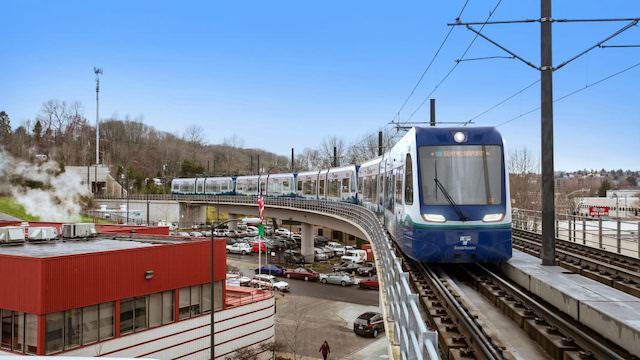Mariya Frost, of the Washington Policy Center, has alerted me that Seattle should be added to the list of cities with transit projects gone wild. Sound Transit, the region’s rail transit authority, has raised the projected costs of projects built between 2017 and 2046 from $54 billion to $142 billion.
An artist’s impression of a planned Seattle light-rail line. Notice that the artist didn’t project any decline in automobiles or driving. Photo from Siemens.
Most of the increase is for the cost of building 62 miles of light-rail lines. Seattle already had the most-expensive light-rail system in the nation, but the latest costs are completely insane.
Seattle-area voters created Sound Transit in 1996, approving $3.9 billion in spending on 19 miles of light rail, a 1.6-mile streetcar in Tacoma, and 73 miles of commuter-rail lines. In 2008, voters agreed to spend $17.8 billion on a 36-mile expansion of light rail plus 10 more miles of commuter rail. Then, in 2016, gullible voters agreed to spend another $53.8 billion building 61 more miles of light rail. That $53.8 billion is what has blown up to $142 billion.
Some of that money will go for improvements to the existing light- and commuter-rail lines as well as operating costs, so we can’t just divide $142 billion by 61 miles to get the cost per mile. But that average cost is clearly going to be very high. Originally, the 61 miles of light rail were expected to cost $31.7 billion, or roughly half a billion per mile. Now it appears that cost will be well above a billion dollars per mile.
As shown in the illustration above, one reason why costs are so high is that the trains will be elevated or in tunnels for almost their entire length. But platforms will only be long enough for four-car trains. Since each car can carry about 150 people and Sound Transit can safely operate only 20 trains per hour, that’s about 12,000 people per hour, less than half the capacity of bus-rapid transit lines. This is why I call Seattle’s light rail a high-cost, low-capacity system.
Of course, considering recent events, Seattle probably won’t need true high-capacity transit in the future. As of March, Seattle’s total transit ridership was only 60 percent of pre-pandemic levels. Most former downtown employees are still working at home. Violent crime downtown is discouraging them from ever coming back. Amazon, which had located tens of thousands of its employees in downtown Seattle, is relocating many to other places or allowing them to work at home. Office vacancy rates are around 13 percent, the highest since the 2008 financial crash. Even employees who return to work in downtown will probably do so on a hybrid basis.
In short, all of the money Seattle is spending on light rail is doubly wasted: first because buses could have carried more people for less more and second because ridership is not likely to ever return to pre-pandemic levels. This is what happens when the goal becomes to build rail and not to provide efficient transportation.









No price is spared no expense….
For 100 billion dollars we expect leather seats, titanium and gold fixtures, private booths……. this level of luxury already exists….. in the airline industry
“… but the latest costs are completely insane.”
That’s because the amount of available money is projected to be completely insane and the projections are based on continuation of current money flow, which is completely insane. All of this is based on an assumption that Democrats will continue to be elected, which is off the wall completely insane.
The feds are throwing money into the streets. Seeing it squandered should have been expected.
It’s natural for any company as it grows to add more office locations. Still, at some point, you have to wonder if Amazon’s planning on a future without a presence in downtown Seattle. Don’t forget their big HQ2 thing from a few years ago.
https://www.aboutamazon.com/news/job-creation-and-investment/amazons-new-tower-for-the-bellevue-skyline
Amazon submits designs for Phase 2 of Bellevue 600 project to create new offices, park space, retail, and daycare facilities.
In 2020, we announced that we are planning to bring 25,000 jobs to Bellevue as part of the expansion of our Puget Sound headquarters. To accommodate our planned job creation, we’ve been securing office space in Bellevue and have begun construction of the first office tower at 600 108th Avenue NE. Today, we submitted our proposed design for the second tower at Bellevue 600, a downtown location that will become the central hub for our Eastside presence
When you spend other people’s money……to quote John Hammond…. Spared No expense.
Seattle metro area has a population of just over 4 million people.
142 billion…….
Cadillac new Lyriq electric SUV will have a baseline of 63,000 dollars, 142 Billion could buy 2.2 million if these….one for every household…
https://file.kelleybluebookimages.com/kbb/base/house/2023/2023-Cadillac-Lyriq-FrontSide_CALYRIQ2301_640x480.jpg